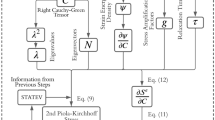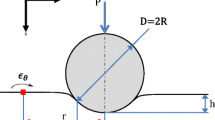Abstract
A method to determine the non-linear viscoelastic constitutive constants from indentation force–displacement data corresponding to different indentation speeds has been developed. The method consists of two parts. In the first part, the force–displacement data is expressed as two functions which represent the strain and the time-dependent responses, respectively. From these functions, the time-dependent constants and the instantaneous force–displacement response are obtained. In the second part, the strain-dependent variables are determined from the instantaneous force–displacement response through an inverse analysis based on the Levenberg–Marquardt method. The method was verified by numerical experiments using the properties of cheese as examples.








Similar content being viewed by others
References
ABAQUS user manual ver 5.8. (1998) Hibbitt, Karlsson, and Sorensen (UK), Cheshire
Carter FJ, Frank TG, Davies PJ, McLean D, Cushieri A (2001) Measurements and modelling of compliance of human and porcine organs. Med Image Anal 5:231–236
Charalambides MN, Goh SM, Lim SL, Williams JG (2001) The analysis of the frictional effect on stress-strain data from uniaxial compression of cheese. J Mater Sci 36:2313–2321
Cheng YT, Cheng CM (1998) Scaling approach to conical indentation in elastic-plastic solids with work hardening. J Appl Phys 84:1284–1291
Costa KD, Yin FCP (1999) Analysis of indentation: implications for measuring mechanical properties with atomic force microscopy. J Biomech Eng, 121:462–471
Dao M, Chollacoop N, Van Vliet KJ, Venkatesh TA, Suresh S (2001) Computational modeling of the forward and reverse problems in instrumented sharp indentation. Acta Mater 49:3899–3918
Fung YC (1993) Biomechanics, mechanical properties of living tissues, 2nd edn. Springer, Berlin Heidelberg New York
Goh SM, Charalambides MN, Williams JG (2003a) Large strain time-dependent behavior of cheese. J Rheol 47:701–716
Goh SM, Charalambides MN, Williams JG (2003b) Mechanical properties and sensory texture assessment of cheeses. J Texture Stud 34:181–201
Goh SM, Charalambides MN, Chakrabarti S, Williams JG (2003c) Rheological characterisation of cheese. 3rd Int Symp Food Rheology and Structure 267–271
Kauer M, Vuskovic V, Dual J, Szekely G, Bajka M (2002) Inverse finite element characterization of soft tissues. Med Image Anal 6:275–287
Kilian HG (1982) Thermo-elasticity of networks. Colloid Polym Sci 260:895–910
Larsson PL, Carlsson S (1998) On microindentation of viscoelastic polymers. Polym Test 17:49–75
Nakamura T, Wang T, Sampath S (2000) Determination of properties of graded materials by inverse analysis and instrumented indentation. Acta Mater 48:4293–4306
Radok JRM (1957) Viscoelastic stress analysis. Q Appl Math 15:198–202
Sakai M (2002) Time-dependent viscoelastic relation between load and penetration for an axisymmetric indenter. Phil Mag A 82:1841–1849
Sakai M, Shimizu S (2001) Indentation rheometry for glass-forming materials. J Non-Cryst Solids 282:236–247
Schnur DS, Zabaras N (1992) An inverse method for determining elastic material properties and a material interface. Int J Numer Methods Eng 33:2039–2057
Tunvisut K, O’Dowd N, Busso EP (2001) Use of scaling functions to determine mechanical properties of thin coatings from microindentation tests. Int J Solids Struct 38:335–351
Acknowledgements
The author SMG currently holds a Research Fellowship of the Royal Commission for the Exhibition of 1851.
Author information
Authors and Affiliations
Corresponding author
Rights and permissions
About this article
Cite this article
Goh, S.M., Charalambides, M.N. & Williams, J.G. Characterisation of non-linear viscoelastic foods by the indentation technique. Rheol Acta 44, 47–54 (2004). https://doi.org/10.1007/s00397-004-0371-x
Received:
Accepted:
Published:
Issue Date:
DOI: https://doi.org/10.1007/s00397-004-0371-x




